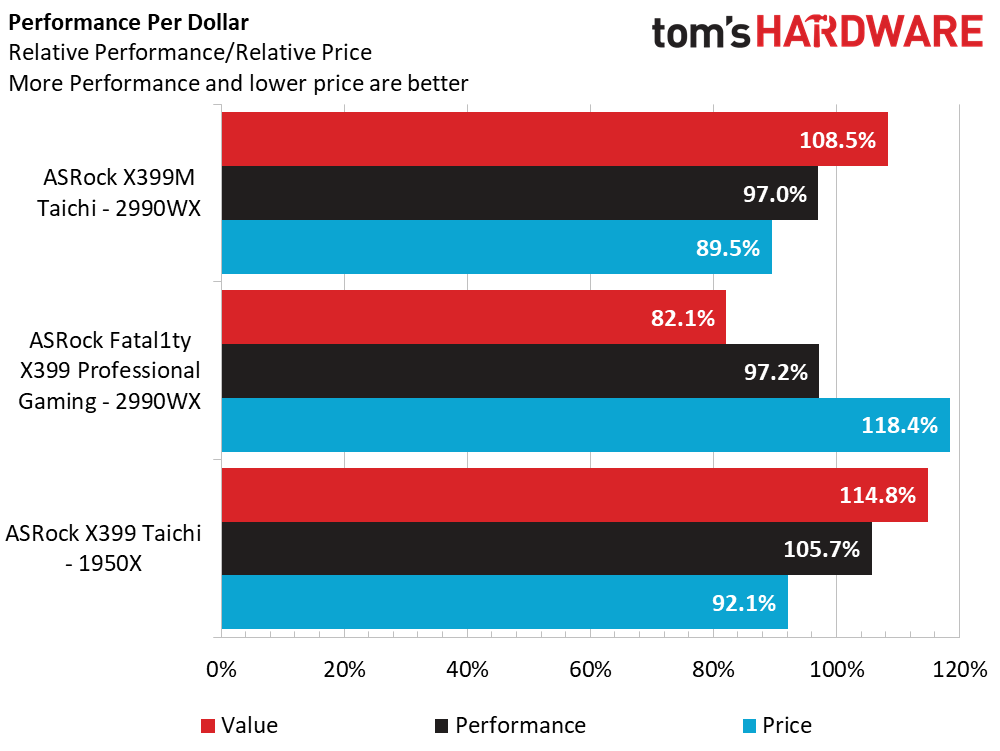ASRock X399M Taichi Review: TR4 Goes Tiny
Why you can trust Tom's Hardware
Power, Thermals, Efficiency, Value and Conclusion


With the 1950X populated in the system, the ASRock X399M manages excellent idle and GPU torture metrics but gets docked for full CPU and average system load measurements by 6.4% when compared to the full-sized Taichi. Temperatures with this processor are also comparable to the intake radiator measurements of the Gigabyte and ASRock boards but the VReg cooler is toasty running 25 degrees Celsius hotter than its big brother. This spells concern as we install the higher wattage 32-core SKU.


The 2990WX is specified as a 250W part and loading the module with Prime95 Small FFTs pushes a total system power draw of 404W or 50% more power than the 1950X. It also feels very fulfilling to be running a processor at a higher power draw than our GPU for once, granted the GPU stress is burning more system power than the 1950X likely due to the larger processor. These larger percentages transfer to the combined torture test and the overall average metric, thus further proving that an 800W supply or better is required for full system stress. If my wife is reading this, sorry our power bill is higher this month.
Taking another glance at thermals, the 2000 series processors will always boost up to the thermal limit of 67.8C before throttling back the boost frequency of the processor. With that in mind, both ASRock boards boosted to similar levels before dialing back and equalizing around 3100MHz boost clocks. The downside here is the regulator temperatures, running 87C above ambient most certainly proves we’re pushing this board's thermal limits in its current configuration. This will be something that needs addressing when we assemble our little monster.


Efficiency is a tough sell for this platform and surprisingly the 1950X data is fairly tight across all the samples. Unfortunately, the X399M encounters elevated full-system load which tips it into the red for efficiency, but it is still relatively close. With that 32-core processor, power consumption is its middle name and clearly gets defeated by the 1950X considering the few wins in our benchmarks and drawing extra power from the wall during load. As for the X399M Taichi, it performs marginally better than the Fatal1ty board with the 32-core processor thanks to the slight power and performance advantage.
Final Thoughts


The ASRock X399M Taichi performs just as well as its larger ASRock sibling boards, and sacrifices connectivity, expandability, and some aesthetics to cram X399 into the Micro-ATX form factor. Putting aside the purist in me, this board makes sense from a value perspective. If all you're looking for is cores and speed, the added benefit of PCIe, DIMMs, and arguably storage are well worth the exclusion and cheaper price tag. At MSRP, this board squeaks by the larger Taichi by only $10 USD which is insignificant given the price of the rest of the hardware.
However, taking sales prices at the time of this publication, a savings of $20 USD could be the difference in a cooler selection, additional NVMe capacity, or even bumping up GPU tiers. Given our analysis of all the X399 boards from ASRock, the shared VReg cooling solution almost makes it essential to get a monoblock for extreme overclocking or prolonged high load use cases, so that $20 savings might be helpfully spent toward a custom cooling loop.
We put this tiny Taichi board through more than our usual spate of tests. And while a compact mATX Threadripper solution originally didn’t hold a whole lot of interest, the X399M Taichi opened our eyes to the possibilities of building a compact powerhouse PC. ASRock delivers full-sized performance in a smaller package at a price that is more palatable for a builder looking to dive into the HEDT scene. And to top it off, it can drive even the most demanding workloads and hardware that can be thrown at it, earning it a Tom’s Hardware Editor’s Choice award.
Get Tom's Hardware's best news and in-depth reviews, straight to your inbox.
MORE: Best Motherboards
MORE: How To Choose A Motherboard
MORE: All Motherboard Content
Current page: Power, Thermals, Efficiency, Value and Conclusion
Prev Page Overclocking: Two Stories, Similar Results